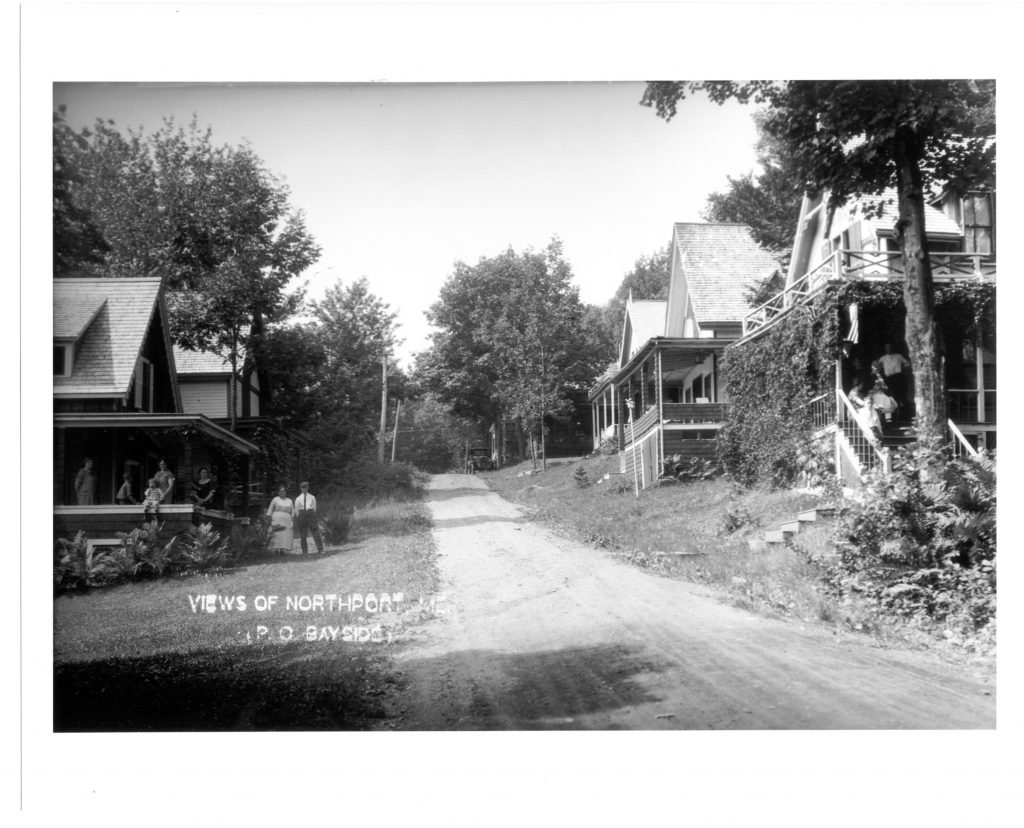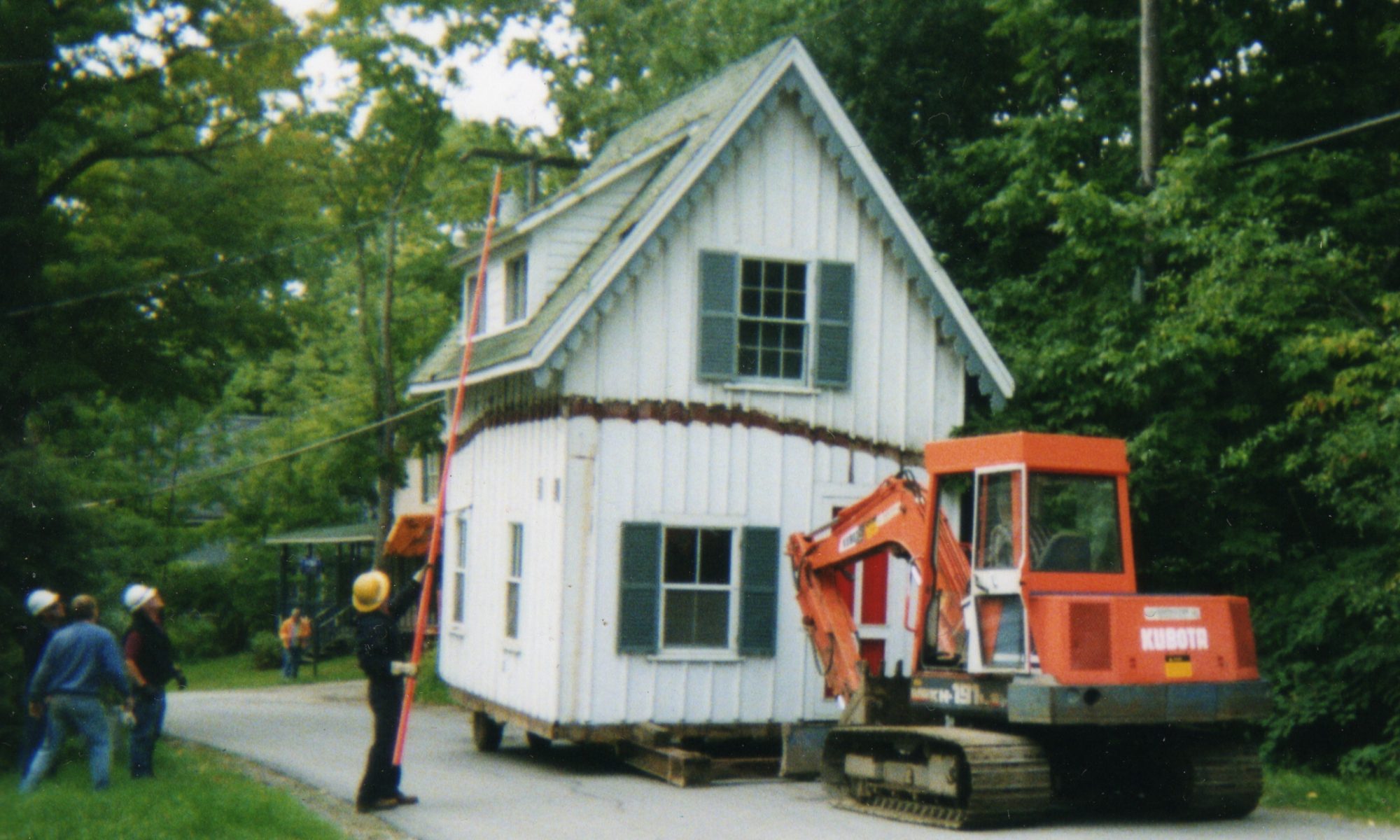By Robert R. Sherman
“FOR SALE––BUYER MUST MOVE,” read the sign posted on the small cottage on Griffin Street just off Broadway in the fall of 2002. The owners had decided the cottage was in too poor a condition to rehab and they wanted to clear the lot to build a new cottage. For years members of the Bayside Historical Preservation Society had dreamed of having a cottage to portray the early life in the Wesleyan Grove Campground and to use as a museum for Bayside memorabilia. Now was the time! But they had very little time and very little money. They approached the owners, Kim Shelley and Burt Sturrup, who agreed to donate the cottage to the Historical Society if the society could arrange to have it moved.
Donations of money, time, labor and supplies enabled the cottage to be moved and reconstructed. First there was the donation of the cottage itself. Then the mover, Bob Allen, offered to halve his fee for moving the cottage. The Sunshine Lady Foundation donated a goodly sum of money to reconstruct and refurbish the cottage. Many persons in the Bayside community gave money, time and labor, materials, and artifacts to create the museum. MBNA gave grants to help with the move and to scan archival materials before display. Central Maine Power donated their services for moving electric wires. Everyone was eager to have a museum to display old Bayside.
The cottage was thought to date from the 1880s; its dimensions corresponded to the 20’ by 50’ tent platforms on which the first campground cottages were built—small and narrow, tall to afford an upstairs, and with a steep roof. An addition had been attached to the back of the cottage, and a porch ran along the front and one side of the cottage. These had already been removed before the cottage was offered for sale. The cottage had been “winterized” and lived in year-round until recently. The immediate thing to do was to move it off the lot and out of the way of the new construction.

Much ingenuity and know-how but no great amount of equipment were required to move such a small cottage. Some jacks, two steel I-beams, a set of dolly wheels, a tracked backhoe, and two or three men did the job. The cottage was to be “parked” temporarily, for the winter, behind the library on George Street, until a permanent location could be selected the following spring. The cottage moved out onto Griffin Street, made a left turn and proceeded inch by inch up the street while utility men guided it beneath their lines, made a right turn on George Street, and was backed into place behind the library. The back side, wide open to the elements after the removal of the addition, was closed in with plywood, the cottage was given a temporary coat of paint to make it more presentable among its neighbors, locks were put on the doors, and it was settled for the winter.
A second move was made the following spring. Again the tracked backhoe moved the cottage back onto George Street and then down Pleasant Street to a lot adjacent to what is popularly known as “Cradle Park” and officially known as Grove Street where the Overseers had offered a long-term dollar-a-year lease. The lot had been cleared of small trees and underbrush, and the movers had poured concrete piers to receive the cottage. Again, Bob Allen and his movers showed their skill in maneuvering the cottage into place, over gullies, rocks and mounds of earth, and setting it on the piers.
Now came the time for volunteer help. Dick Brockway and Rob Sherman began the carpentry. To restore authenticity, they first had to remove the insulation, studding, and electric wiring that had been used to winterize the cottage. These materials were not simply thrown away. The insulation was given to a roofer to be recycled in a house he was building, and the studding and other lumber were used, wherever they could be, in reconstructing the cottage.
An unusual effect of stripping the inside of the cottage was that, when the electric wiring was removed, there remained dozens, perhaps hundreds, of holes in the studding and overhead joists where the wiring had been passed through. It looked like Swiss cheese! How to plug such holes—and so many of them? A bright idea was suggested that wine corks would do the trick. A call went to the community for wine corks, though a droll wit wondered whether enough could be found in a former Methodist campground. No worry, more than enough were donated, the holes were plugged and, once painted, can hardly be noticed.
A next step was to re-roof the building. Spring rains had shown that the old roof would keep no one dry. In days gone by, cedar shingles were used for roofing, but for many decades now, asphalt shingles have been used. To maintain the look of the authentic roof boarding that can be seen from the inside of the cottage, plywood was laid over the old boards and the new roof was then installed on top of that. A professional roofer was employed to do that—thanks to donated funds. The cottage is now watertight and snug.
The open back was boarded in, a backdoor installed, and a window put in on the second floor. Some older Baysiders had hoarded bits and pieces of lumber and trim that were used for that purpose. A window frame was made and installed, using an older sash. Finding a suitable door was another matter. Rob and Dick driving around one day found a door at second-hand building supply yard in far away Windsor, and the door was installed. Serendipity entered here. They were told that the door originally came from a house in Belfast! There is no proof of that provenance, but it is nice to think so. A front door salvaged from his Bayside cottage was donated by Ralph Robinson.
Like many of the cottages built in the later 1800s, the cottage was sheathed with vertical board and batten. The battens were about two inches wide and half round—hard to find today. A few extra pieces were stored in the cottage, but not enough for all the new boarding on the back. But new batten, slightly less wide than two inches, was found, and when nailed down and painted, the difference in appearance and authenticity is hardly noticeable.
Taken from IF THESE COTTAGES COULD TALK a history of Bayside in Northport, Maine, published by the Bayside Historical Preservation Society, 2007 and available at Left Bank Books, Belfast, Maine

